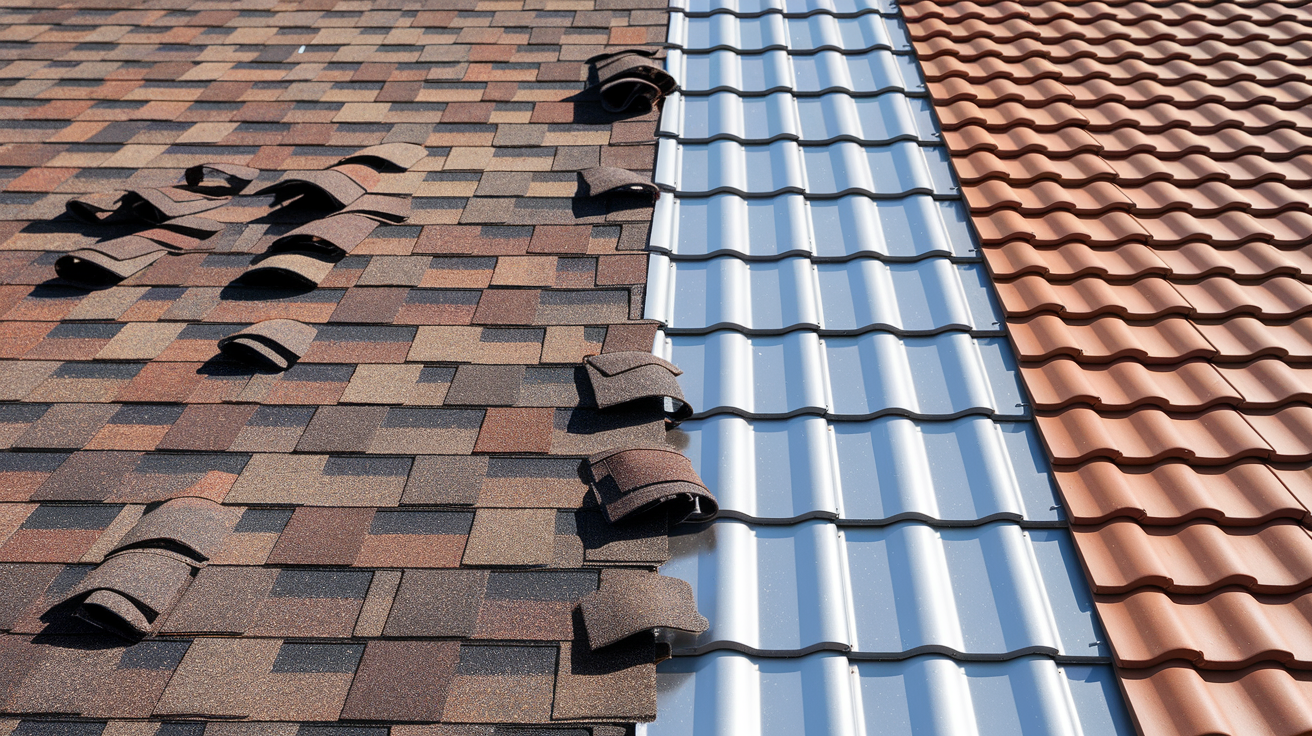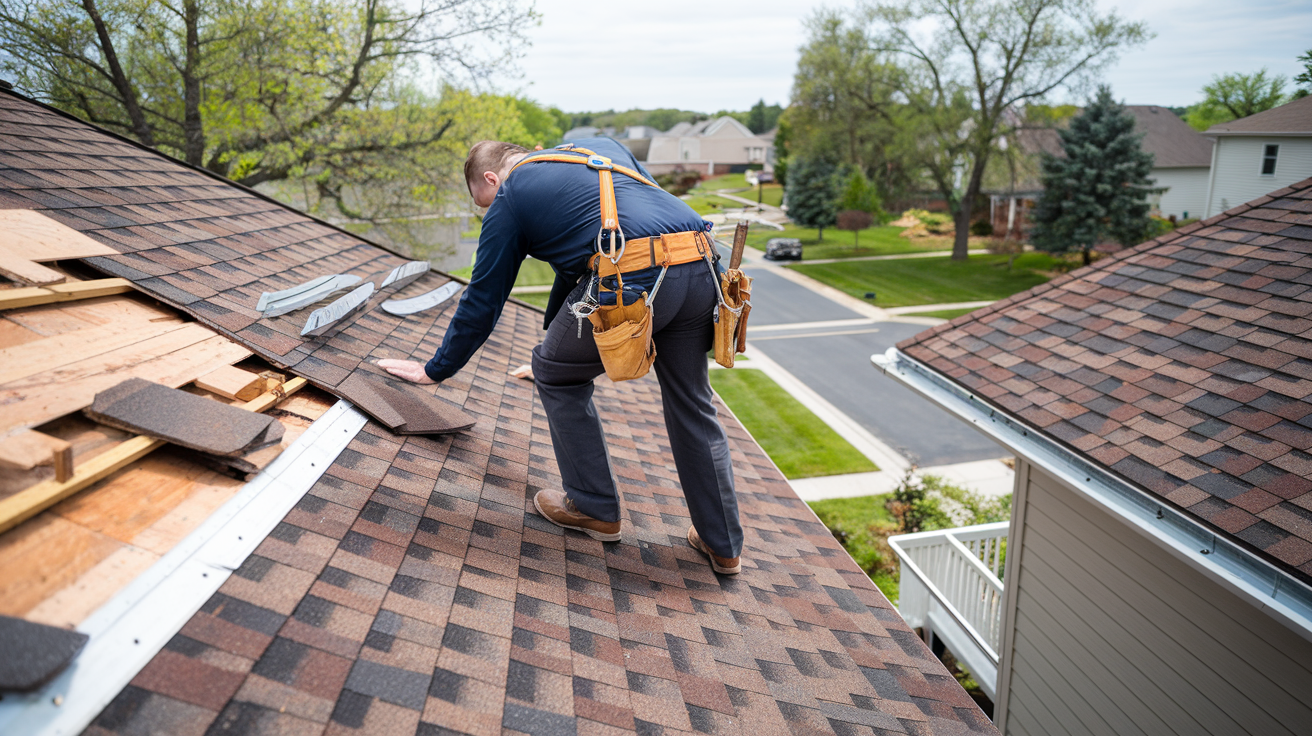Summer Roof Protection: Expert Guide to Heat & Storm Defense
Is your roof ready for the scorching summer ahead? Every year, homeowners face thousands in unexpected repairs from heat damage, UV radiation, and severe storms. The average roof replacement costs between $4,000 and $12,000 - but many of these expenses could be prevented with proper summer maintenance and protection.
Your roof is your home's first line of defense against extreme weather, yet many homeowners overlook critical summer maintenance until it's too late. With asphalt shingle temperatures reaching up to 150°F on sunny days, and UV radiation constantly breaking down roofing materials, summer poses unique challenges that require specific preventive measures.
In this comprehensive guide, you'll discover proven strategies to protect your roof from summer's harshest elements. We'll explore cost-effective maintenance tips, the best materials for different climates, and expert insights on preventing expensive damage. Whether you're dealing with intense heat, frequent storms, or high humidity, you'll learn exactly what steps to take to extend your roof's lifespan and avoid costly repairs.
- Understanding Summer Roof Challenges
- Preparing Your Roof for Summer
Understanding Summer Roof Challenges
Summer presents unique challenges for roofs, combining intense heat, UV radiation, and powerful storms. Each factor can significantly impact a roof's lifespan and integrity, potentially leading to costly repairs if left unaddressed. Understanding these challenges is crucial for homeowners wanting to protect their investment and ensure their roof's longevity. Proactive measures and awareness of potential risks can mitigate damage and maintain a robust, reliable roof throughout the summer.
| Challenge | Impact | Solution |
|---|---|---|
| Intense Heat | Causes shingles to curl, crack, and melt | Use heat-resistant materials |
| UV Radiation | Degrades materials, causing fading and brittleness | Consider cool roofs and UV-resistant materials |
| Storms | Wind and water damage to shingles and structure | Reinforce vulnerable areas and ensure good drainage |
The Impact of Heat on Different Roofing Materials
Heat is a primary concern for roofs, especially during summer's soaring temperatures. Asphalt shingles, a common roofing material, can reach 150°F on sunny days (source: US Department of Energy). This extreme heat can cause shingles to curl, crack, and melt, compromising the roof's protective barrier. Signs of heat damage include cracked or curled shingles and granules in your gutters. For an expert assessment of potential heat damage, schedule a Get Your Roof Assessment.
Metal Roofs and Heat
Metal roofs offer better heat resistance due to their reflective properties and ability to dissipate heat quickly. The metal reflects sunlight, absorbing less heat than asphalt shingles, and radiating heat away from the roof surface. However, temperature fluctuations can cause expansion and contraction, potentially loosening fasteners or warping panels. Metal roofs typically require specialized fasteners designed to accommodate this movement without damage.
Tile and Slate Roofs and Heat
Tile and slate roofs provide excellent heat resistance, but their weight can create structural challenges. Their added weight may necessitate reinforced framing, increasing installation costs.

UV Radiation and Its Effects on Roof Longevity
UV radiation is another significant summer threat to roofs. Prolonged UV exposure degrades roofing materials, causing fading, brittleness, and reduced strength. Asphalt shingles, for example, can lose protective granules crucial for deflecting sunlight and preventing water infiltration. This loss appears as bare spots on shingles or granule accumulation in gutters, impacting both aesthetics and functionality.
Cool Roofs and UV Protection
Cool roofs, made with reflective materials, mitigate UV radiation effects by reflecting more sunlight and absorbing less heat. Consider a cool roof if you live in a sunny climate, prioritize energy efficiency, or want to extend your roof's life. Cool roofing techniques enhance energy efficiency and roof lifespan. By reflecting sunlight, cool roofs reduce heat absorption, lessening air conditioning needs and lowering energy bills. To learn more about roof maintenance and explore cool roof options, visit our information page.
Tip: Choosing a cool roof can reduce your energy bills by up to 15% during summer months. This not only saves money but also extends the life of your roof by reducing thermal stress.
Regional Weather Patterns and Storm Threats
Regional weather patterns significantly influence summer roof challenges. Storm-prone areas face wind and water damage risks. Strong winds can lift shingles, allowing water penetration and leaks. While generally more wind-resistant, metal roofs can still experience damage in extreme winds, particularly hurricanes.
Heavy Rainfall and Drainage
In regions with frequent heavy rain, proper drainage is crucial. Regularly cleaning gutters and downspouts removes debris, ensuring free water flow and preventing ponding and potential damage.
Storm Preparation
Preparing for severe weather by reinforcing vulnerable areas like chimneys, vents, and skylights, which are susceptible to leaks, and ensuring proper ventilation, significantly reduces storm-related damage. By understanding summer's challenges, homeowners can implement effective roof protection strategies. Regular inspections, timely repairs, and appropriate roofing materials help withstand harsh summer elements, ensuring your roof remains a reliable shield.

Preparing Your Roof for Summer
As summer approaches, homeowners must prepare their roofs for intense heat, UV radiation, and strong storms. Proper preparation can prevent costly repairs and extend your roof's lifespan. A proactive approach ensures your roof remains resilient and protects your home. This section guides you through inspecting for common summer damage, essential maintenance tips, and selecting suitable roofing materials for your regional climate.
Inspecting for Common Types of Summer Damage
Summer weather can cause several types of roof damage. Ignoring these problems can lead to significant expenses later. Start by inspecting your roof for visible damage.
Visible Signs of Damage
Look for missing or torn shingles, often caused by high winds or hail. These are clear signs of storm damage requiring attention. Document this damage for insurance, including descriptions and any related injuries.
Flashing and Other Issues
Also, check for cracked or worn flashing, especially around vents and chimneys. High temperatures can deteriorate these materials, leading to leaks and further damage. Inspect for tree damage, as falling branches can impact your roof, especially after storms. Finally, address any stagnant water, which can cause leaks and mold growth, often due to clogged gutters or damaged flashing. Schedule a Get Your Roof Assessment to identify potential issues early.
Checklist for Roof Inspection
- Missing or torn shingles
- Cracked or worn flashing
- Tree damage
- Stagnant water issues
Essential Maintenance Tips for Homeowners
Routine maintenance is crucial for protecting your roof during summer. These simple steps can prevent significant problems.
Gutter Maintenance
Clean your gutters to ensure proper drainage and prevent water buildup that can damage your roof. Inspect them for damage and clear out debris.
Professional Inspection
Schedule a professional roof inspection to assess your roof's condition and identify hidden issues. Professionals can often spot problems homeowners might miss. DIY roof repair can be risky and may cause more damage. Consider learn more about roof maintenance for helpful tips and guidance.
Attic Ventilation
If you have an attic, ensure proper ventilation to reduce heat buildup, which can degrade roofing materials. Good ventilation significantly extends roof lifespan, especially in hot climates.
Reflective Coatings
Consider applying a reflective roof coating to minimize heat absorption and prolong your roof's life. Reflective coatings lower roof temperatures, especially on asphalt shingles, which can reach 150°F on sunny days. This prevents premature aging and cracking.
Choosing the Right Roofing Materials for Your Region
The right roofing materials are crucial for withstanding summer weather. Consider your local climate and consult with a roofing professional for the best recommendations.
Material Performance in Different Climates
In hot, sunny regions, materials like metal or slate offer excellent durability and reflectivity, reducing heat absorption. Metal roofs can last 70 years or more. Asphalt shingles, while cost-effective and popular, are more susceptible to heat damage, becoming brittle and cracking. They typically last 15-30 years.
Impact-Resistant Shingles
For storm-prone areas, impact-resistant shingles offer additional protection against wind and hail. Choosing climate-appropriate materials significantly reduces long-term maintenance costs. Metal roofs, despite higher initial costs, require less maintenance.
Local Climate Considerations
Consider local weather patterns beyond general climate zones. In Northern California, abundant sunshine means high UV radiation and heat exposure, making material choice crucial.

Protecting Your Roof from Sun and Storm Damage
As summer approaches, protecting your roof from the damaging effects of sun and storms becomes increasingly important. Intense sunlight, high temperatures, and severe weather can significantly impact your roof, leading to expensive repairs or even a full replacement, which can cost between $4,000 and $12,000. Proactive measures can protect your home and extend the life of your roof. This section explores the benefits and costs of roof coatings, selecting UV-resistant materials, and reinforcing your roof against storms.
Benefits and Cost Implications of Roof Coatings
Roof coatings create a protective layer against the sun's harsh effects. They reflect UV rays, which degrade roofing materials, and reduce heat absorption. This keeps your home cooler and minimizes thermal stress on roofing materials, extending their lifespan. Cool roof coatings can save you up to 15% on energy costs by reducing the need for air conditioning. While applying a roof coating can cost between $1 and $4 per square foot, the long-term savings on energy and maintenance can make it a worthwhile investment. Consider getting a roof assessment to determine the best coating for your roof.
Selecting Materials with High UV Resistance
Choosing roofing materials with inherent UV resistance is crucial for minimizing sun damage. Materials like metal and clay tiles are known for their durability and resistance to prolonged sun exposure. Metal roofs can last up to 70 years and often have reflective coatings that further enhance UV resistance. This long lifespan results in lower long-term maintenance costs compared to other materials that require more frequent repairs. Asphalt shingles, which represent a significant portion of the residential roofing market, are available with reflective granules that reduce heat absorption. Learn more about roof maintenance to choose the best materials for your climate.
Reinforcing Structures to Withstand Storms
Storm damage is a significant concern, especially during summer. Reinforcing your roof structure can help it withstand high winds and heavy rain. Techniques like installing hurricane clips, which secure the roof to the walls, and using thicker plywood for roof decking can increase resilience. Excessive rain can cause water pooling, leaks, and damage to shingles, flashing, and gutters. In areas with severe weather, impact-resistant shingles can prevent damage from hail and wind-blown debris, saving you money on repairs. Investing in these reinforcements protects your home and may lower insurance premiums. By taking these proactive steps, you can protect your roof from sun and storm damage, ensuring the longevity and safety of your home.
Regional Considerations for Summer Roof Care
Summer roof care needs vary significantly based on regional climate. Heat and sun are common concerns, but storms also present serious threats. Understanding your region's specific challenges helps tailor your roof care strategy effectively. Whether your area is humid, arid, or storm-prone, preparation is key to saving time and money.
Maintenance Practices for Humid vs. Arid Climates
Humid climates expose roofs to frequent rain and moisture. This can lead to mold, algae growth, and wood rot.
Humid Climate Maintenance
Proper ventilation and drainage are crucial in humid climates. Ensuring proper ventilation means allowing air to circulate in the attic and under the roof deck. This circulation helps prevent moisture buildup. Adequate intake vents (like soffit vents) and exhaust vents (like ridge vents or gable vents) create necessary airflow. Regularly cleaning gutters and checking for leaks are also essential.
Arid Climate Maintenance
Arid climates present different challenges. Intense heat and UV radiation can cause roofing materials to crack and degrade. UV radiation breaks down the chemical bonds in roofing materials, leading to brittleness and cracking. Asphalt shingles are particularly vulnerable, becoming dry and brittle with prolonged sun exposure. Selecting UV-resistant materials like metal roofing or certain tiles, and conducting regular inspections, can extend roof lifespan. Inspect your roof at least annually, ideally in spring or fall. After extreme heat, check for damage. You can learn more about roof maintenance.
| Climate Type | Maintenance Focus |
|---|---|
| Humid | Ensure proper ventilation and drainage, clean gutters regularly |
| Arid | Use UV-resistant materials, conduct regular inspections |
Addressing Hail and Wind Damage in Storm-Prone Areas
Storm-prone areas face hail and high winds, both causing significant roof damage. Hail can crack or puncture shingles. High winds can lift or remove roofing materials. The size and density of hail, along with wind speed, greatly affect the damage. High winds are especially dangerous at roof edges and corners, where they create uplift, tearing shingles or entire sections away. Wind pressure is often higher in these areas.
Protecting Your Roof in Storm-Prone Areas
Install impact-resistant roofing materials and reinforce roof edges and corners. Impact-resistant shingles withstand hail impacts. Proper sealing and fastening of roof edges resist wind uplift. Regular inspections after storms help identify and address damage promptly. If you suspect damage, contact a qualified roofing professional for a thorough assessment and repair recommendations. Consider a Get Your Roof Assessment.
Customizing Care for Local Climate Conditions
Local weather patterns, beyond broad climate categories, influence ideal roof care. Regions with frequent temperature fluctuations experience thermal shock, compromising roofing materials. Rapid temperature changes cause materials to expand and contract, leading to stress and cracks, especially in asphalt shingles. Choosing thermally resilient materials and maintaining consistent insulation mitigates damage. Proper attic ventilation regulates temperature extremes. Areas with sporadic heavy rain should enhance drainage systems to prevent water pooling and leaks. Ensure clear gutters and consider larger downspouts or additional drainage points. Regularly check for and address leaks. Understanding your local climate and customizing your approach protects your home year-round.
Long-Term Roof Care Strategies
Long-term roof care is crucial for ensuring the durability and safety of your home. Roofs face constant exposure to the elements. A comprehensive maintenance strategy prevents costly damage and extends your roof's lifespan. This section explores effective long-term care strategies. We'll emphasize regular maintenance, professional inspections, and balancing maintenance with material investments. Get Your Roof Assessment can help you create a personalized long-term care plan.
Developing a Regular Maintenance Schedule
A regular maintenance schedule helps catch potential issues early. Inspect your roof twice a year, in spring and fall, to check for damage from winter or summer weather. Also, inspect after severe weather like hail or strong winds. Regular checks identify problems like missing shingles, cracked flashing, or clogged gutters. These can cause leaks and water damage if ignored. Proactive maintenance reduces emergency repairs and extends roof life. How often should you replace your roof? It depends on the material, quality, and environment. Asphalt shingles last 15-30 years, while metal roofs last 40-70 years or more. Learn more about roof maintenance to develop a personalized schedule.
Key Maintenance Activities
- Gutter Cleaning and Inspection: Clean gutters prevent water buildup and leaks. Clogged gutters overflow, causing roof damage. Clean gutters in spring and fall.
- Roof Material Assessment: Check for damaged or missing shingles. Look for curling, cracking, or missing shingles. Look for granule loss on asphalt shingles, a sign of aging.
- Examination of Roof Flashings: Ensure flashings are sealed to prevent leaks. Flashings seal around chimneys and vents. Damaged flashing commonly causes leaks. Check for rust, cracks, or gaps.
- Attic Ventilation Inspection: Good ventilation reduces heat and moisture, preventing damage. Poor ventilation causes overheating and moisture buildup, shortening roof lifespan.
Importance of Professional Inspections
Regular homeowner maintenance is important. But professional inspections provide a deeper analysis. Professionals find hidden issues, like structural problems or small leaks. They use tools like moisture meters and infrared cameras. These detect moisture or heat loss. Professional inspections cost $150 to $400 on average. A basic inspection visually assesses the roof. A detailed inspection may include a drone or infrared scan. Professional inspections are crucial after storms. This helps identify damage for insurance claims.
Benefits of Professional Inspections
- Comprehensive Assessment: Professionals use special tools to evaluate your roof.
- Early Problem Detection: Finding problems early prevents costly repairs later.
- Expert Recommendations: Professionals recommend materials and practices for your roof and climate. They might suggest coatings for flat roofs in certain areas. They can also advise on ventilation and insulation.
Cost Analysis: Balancing Maintenance and Material Investments
Balance maintenance costs with material investments for effective care. Investing in quality materials and maintenance saves money long-term. Asphalt shingles are cost-effective, making up 81% of the residential market because they are durable. Asphalt shingles cost $3 to $5 per square foot. Metal roofs cost more upfront but last up to 70 years, saving on replacement and maintenance. All roofs need maintenance, but metal roofs need fewer repairs. They resist moss and cracking. Maintaining asphalt shingles includes cleaning, moss removal, and flashing repair. These costs add up, especially without regular maintenance.
Strategic Investment Tips
- Choose Durable Materials: Pick materials suited to your climate. Consider local weather, like heavy rain. Choose materials that can handle temperature swings in areas with extreme heat or cold.
- Budget for Regular Maintenance: Set aside money for inspections and minor repairs. Metal or slate roofs may need special cleaning, adding $50-$100 to costs. Budget for repairs like replacing shingles or flashing.
- Consider Energy Efficiency: Metal roofs reflect heat, reducing energy costs in hot climates. Dark shingles can reach 150°F, increasing cooling costs. Lighter roofs reflect sunlight and keep your home cooler.
In conclusion, balanced roof care involves regular maintenance, professional inspections, and smart material choices. This protects your home and extends roof life. DIY repairs are risky and can cause more damage. Professional services are safer and often more cost-effective. Professionals have the expertise and tools for safe and effective repairs.
Disclaimer: This blog post is intended for informational purposes only and should not be considered professional roofing advice. Always consult with qualified roofing contractors and insurance professionals for specific guidance regarding your individual circumstances.
